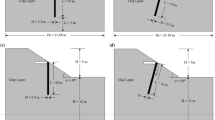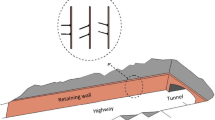Abstract
This paper presents an innovative approach to shaping embedded retaining walls using hybrid piles with flexible shafts. The tests of the hybrid piles in sand confirmed that their displacement is 30–50% less compared to the standard piles at the same lateral load. The general concept of retaining walls with hybrid piles is described, assumptions are formulated and model tests, and full-scale tests and 3D FEM analyses are carried out to evaluate the response mechanism of hybrid piles in sand. It was confirmed that flexible hybrid piles interact with the soil in a different way than standard piles. Particular attention was paid to evaluation of pile displacements during the initial phase of increasing the lateral load up to H = 400 kN, M = 1600 kNm with M/H ratio = 4. It was found that changes in lateral stiffness of the hybrid pile increase with pile deflection in the range up to 50 mm. The long-term field tests showed that the hybrid piles L = 10 m, D = 1.2 m, slab overhang B = 1.2 m were stable for a period of eight months. Detailed 3D FE numerical analysis of the stress zones in front of the hybrid pile allowed new P–Y curves to be proposed for depths up to 2 m in the range of initial displacements. Simplified verification calculations using the modified p–y curves for hybrid piles with flexible shafts were carried out, and positive verification results were obtained for test piles in sand.





















Similar content being viewed by others
References
Kim JB, Singh LP, Brungraber RJ (1979) Pile cap soil interaction from fullscale lateral load tests. J GeotechEng Div ASCE 105(5):643–653. https://doi.org/10.1061/AJGEB6.0000800
Budiman J, Ahn K (2005) Effects of pile cap in single pile and lateral capacity of pile group. Adv Deep Found ASCE Geo-Front Congress, Austin. https://doi.org/10.1061/40778(157)26
Duncan J, Mokwa R (2001) Passive earth pressures: theories and tests. J Geotech Geoenviron Eng ASCE 127(3):249–257. https://doi.org/10.1061/(ASCE)1090-0241(2001)127:3(248)
Mokwa R, Duncan J (2001) Experimental evaluation of lateral-load resistance of pile caps. J Geotech Geoenviron Eng ASCE 127(2):185–192. https://doi.org/10.1061/(ASCE)1090-0241(2001)127:2(185)
Mokwa R, Duncan J (2003) Rotational restraint of pile caps during lateral loading. J Geotech Geoenviron Eng ASCE 129(9):830–837. https://doi.org/10.1061/(ASCE)1090-0241(2003)129:9(829)
Rollins KM, Cole R (2006) Cyclic lateral load behavior of a pile cap and backfill. J Geotech Geoenviron Eng ASCE 132(9):1143–1153. https://doi.org/10.1061/(ASCE)1090-0241(2006)132:9(1143)
Powrie W, Chandler RJ (1998) The influence of a stabilising platform on the performance of an embedded retaining wall; a finite element study. Geotechnique 48(3):403–409. https://doi.org/10.1680/geot.1998.48.3.403
Powrie W, Chandler RJ, Carder DR, Watson GVR (1999) Back-analysis of an embedded retaining wall with a stabilising base slab. Proceedings of the Institution of Civil Engineers—Geotechnical Engineering 137 (2): 75–86. https://doi.org/10.1680/gt.1999.370202
Powrie W, Daly MP (2007) Centrifuge modelling of embedded retaining walls with stabilising bases. Geotechnique 57(6):485–497. https://doi.org/10.1680/geot.2007.57.6485
Pedram B (2015) A numerical study on offshore wind turbines embedded in sands. Geotechnical Research 2(2):49–65. https://doi.org/10.1680/jgere.15.00001
Pedram B (2015) Effects of pile shape in improving the performance of monopiles embedded in onshore clays. Can Geotech J 52(8):1144–1158. https://doi.org/10.1139/cgj-2014-0397
Pedram B (2015c) A Numerical Study into the Behaviour of Monopiled Footings in Sand for Offshore Wind Turbines. Doctoral dissertation. The Univ. of Western Australia. https://api.research-repository.uwa.edu.au/ws/portalfiles/portal/5129778/Pedram_Behrang_2015.pdf
Pedram B (2018) Behaviour of hybrid piled footing structures in sands. Geotech Geol Eng 36:2273–2292. https://doi.org/10.1007/s10706-018-0461-7
Pedram B (2021) Ultimate lateral capacity of single piles in cohesionless soils. J Ocean Eng Marine Energy 7:305–325. https://doi.org/10.1007/s40722-021-00193-z
El-Marassi M (2011) Investigation of hybrid monopile-footing foundation systems subjected to combined loading. Doctoral dissertation, The Univ. of Western Ontario.
Lehane BM, Pedram B, Doherty JA, Powrie W (2014) Improved performance of monopiles when combined with footings for tower foundations in sand. J Geotech Geoenviron Eng ASCE 140(7):04014027. https://doi.org/10.1061/(ASCE)GT.1943-5606.0001109
Stone KJL, Arshi HS, Zdravkovic L (2018) Use of a bearing plate to enhance the lateral capacity of monopiles in sand. Journal of Geotechnical and Geoenvironmental Engineering, ASCE 144(8). https://doi.org/10.1061/(ASCE)GT.1943-5606.0001913
Wang X, Zeng X, Li J, Yang X (2018) Lateral bearing capacity of hybrid monopile friction wheel foundation for offshore wind turbines by centrifuge modelling. Ocean Eng 148:182–192. https://doi.org/10.1016/j.oceaneng.2017.11.036
Wang X, Zeng X, Yang X, Li J (2018) Feasibility study of offshore wind turbines with hybrid monopile foundation based on centrifuge modeling. Appl Energy 209:127–139. https://doi.org/10.1016/j.apor.2018.06.005
Wang X, Zeng X, Li X, Li J (2019) Investigation on offshore wind turbine with an innovative hybrid monopile foundation: An experimental based study. Renew Energy 132:129–141. https://doi.org/10.1016/j.renene.2018.07.127
Wang X, Li J (2020) Parametric study of hybrid monopile foundation for offshore wind turbines in cohesionless soil. Ocean Eng 218:108172. https://doi.org/10.1016/j.oceaneng.2020.108172
Trojnar K (2019) Multi scale studies of the new hybrid foundations for offshore wind turbines. Ocean Eng 192:106506. https://doi.org/10.1016/j.oceaneng.2019.106506
Trojnar K (2021) Simplified design of new hybrid monopile foundations for offshore wind turbines. Ocean Eng 219:108046. https://doi.org/10.1016/j.oceaneng.2020.108046
Yang X, Zeng X, Wang X, Yu H (2018) Performance of monopile-friction wheel foundations under lateral loading for offshore wind turbines. Appl Ocean Res 78:14–24. https://doi.org/10.1016/j.apor.2018.06.005
Yang X, Zeng X, Wang X, Berrila J, Li X (2019) Performance and bearing behavior of monopile-friction wheel foundations under lateral-moment loading for offshore wind turbines. Ocean Eng 184:159–172. https://doi.org/10.1016/j.oceaneng.2019.05.043
Wang Y, Zou X, Zhou M, Zhang X (2021) Failure mechanism and lateral bearing capacity of monopile-friction wheel hybrid foundations in soft-over-stiff soil deposit. Mar Georesour Geotechnol. https://doi.org/10.1080/1064119X.2021.1934615
Wang J, Sun G, Chen G, Yang X (2021) Finite element analyses of improved lateral performance of monopile when combined with bucket foundation for offshore wind turbines. Appl Ocean Res 111:102647. https://doi.org/10.1016/j.apor.2021.102647
Li L, Zheng M, Liu X, Wu W, Liu H, El-Naggar HM, Jiang G (2022) Numerical analysis of the cyclic loading behavior of monopile and hybrid pile foundation. Comput Geotech 144:104635. https://doi.org/10.1016/j.compgeo.2022.104635
Richards DJ, Clayton CRI, Powrie W, Hayward T (2004) Geotechnical analysis of a retaining wall in weak rock. Proc Inst Civ Eng Geotech Eng 157(1):13–26. https://doi.org/10.1680/geng.2004.157.1.13
Park JS, Joo YS, Kim NK (2009) New earth retention system with prestressed wales in an urban excavation. J Geotech Geoenviron Eng ASCE 135(11):1596–1604. https://doi.org/10.1061/(ASCE)GT.1943-5606.0000148
Lim A, Hsieh PG, Ou CY (2016) Evaluation of buttress wall shapes to limit movements induced by deep excavation. Comput Geotech 78:155–170. https://doi.org/10.1016/j.compgeo.2016.05.012
Lim A, Ou CY, Hsieh PG (2018) Investigation of the integrated retaining system to limit deformations induced by deep excavation. Acta Geotech 13(4):973–995. https://doi.org/10.1007/s11440-017-0613-6
Lim A, Ou CY, Hsieh PG (2020) A novel strut-free retaining wall system for deep excavation in soft clay: numerical study. Acta Geotech 15:1557–1576. https://doi.org/10.1007/s11440-019-00851-5
Hsiung BCB (2020) Observations of the ground and structural behaviours induced by a deep excavation in loose sands. Acta Geotech 15:1577–1593. https://doi.org/10.1007/s11440-019-00864-0
Hajialilue-Bonab M, Sojoudi Y, Azarnya-Shahgoli H (2011) Soil deformation pattern around laterally loaded piles. International Journaj of Physical Modelling In Geotechnics 11(3):116–125.10680/ijpmg.2011.11.3116
Hajialilue-Bonab M, Sojoudi Y, Puppala A (2013) Study of strain wedge parameters for laterally loaded piles. Int J Geomech ASCE 13(2):143–152. https://doi.org/10.1061/(ASCE)GM.1943-5622.0000186
Hokmabadi AS, Fakhe A, Fatahi B (2012) Full scale lateral behaviour of monopiles in granular marine soils. Mar Struct 29:198–210. https://doi.org/10.1016/j.marstruc.2012.06.001
Ashour M, Norris G, Pilling P (2002) Strain wedge model capability of analyzing behavior of laterally loaded isolated piles, drilled shafts, and pile groups. J Bridge Eng ASCE 7(4):245–254. https://doi.org/10.1061/(ASCE)1084-0702(2002)7:4(245)
Reese LC, Van Impe W (2001) Single Pile and Pile Groups under Lateral Loading. Balkema Publ Rotterdam doi 10(1115/1):1445326
Zhang L, Silva F, Grismala R (2005) Ultimate lateral resistance of piles in cohesionless soils. J Geotech Geoenviron Eng ASCE 131(1):78–83. https://doi.org/10.1061/(ASCE)1090-0241(2005)131:1(78)
Gaba A, Hardy S, Doughty L, Powrie W, Selemetas D (2017) Guidance on embedded retaining wall design. CIRIA C760, London. https://www.ciria.org/ItemDetail?iProductcode=C760&Category=BOOK
Trojnar K (2013) Designing of the hybrid foundations under lateral load. In: Proc. of the Third Conf. on Soil-Structure Interaction, Bialystok, Civil and Env. Eng. Vol.4:237–245 http://pbc.biaman.pl/Content/25949/PDF/2013%20vol.%204%20no.%203.pdf
Trojnar K (2015) Soil-hybrid pile interaction under lateral load. J. Civil Eng. Env. Arch. 32(62):435–446. https://oficyna.prz.edu.pl/zeszyty-naukowe/czasopismo-inzynierii-ladowej-s/jceea-62/jceea-62-04
Peck RB (1969) Deep Excavation and Tunneling in Soft Ground. State-of-the-Art Report. Proceedings of the 7th International Conf. on Soil Mechanics and Foundation Engineering, Mexico, 225–290. https://www.issmge.org/publications/publication/deep-excavations-and-tunneling-in-soft-ground
Cuéllar P, Georgi S, Baeßler M, Rucker W (2012) On the quasi-static granular convective flow and sand densification around pile foundations under cyclic lateral loading. Granular Matter 14:11–25. https://doi.org/10.1007/s10035-011-0305-0
Hayward T, Carder DR, Powrie W, Richards DJ, Barker KJ (2000) Behavior During Construction of a Stabilised Base Embedded Wall at Coventry. ISSN: 0968–4107, www: TRL report 446
Wang Y, Zou X, Hu J (2021) Bearing Capacity of Single Pile-Friction Wheel Composite Foundation on Sand-over-Clay Deposit under V-H-M Combined Loadings. Appl Sci 11:9446. https://doi.org/10.3390/app11209446
Lings ML, Nash DFT, Ng CWW, Boyce MD (1991) Observed behaviour of a deep excavation in Gault Clay: a preliminary appraisal. Proceedings of 10th Conf. SMFE: 467–470. Proceedings of the International Conference on Soil Mechanics and Foundation Engineering
Carder DR, Symons IF (1993) Long term performance of embedded cantilever retaining wall in stiff clay. Geotechnique 39(1):55–75. https://doi.org/10.1680/geot.1989.39.1.55
Watson GVR, Carder DR (1994) Comparison of the measured and computed performance of propped bored pile retaining wall at Walthamston. Proc Inst Civ Eng Geotech Eng 107(3):127–133. https://doi.org/10.1680/igeng.1994.26465
Clark J (2006) Performance of a propped retaining wall at the CTRL, Ashford. Doctoral Dissertation, The Univ. of Southampton.
Hayward T (2000) Field studies, analysis and numerical modelling of retaining walls embedded in weak rock. Doctoral Dissertation, The Univ. of Southampton.
Oleary F, Long M, Ryan M (2016) The long-term behaviour of retainig walls In Dublin. Proc Inst Civ Eng Geotech Eng 169(2):99–109. https://doi.org/10.1680/jgeen.15.00041
Ramadan MI, Ramadan EH, Khashila MM (2018) Cantilever contiguous pile wall for supporting excavation. Geotech Geol Eng 36(3):1545–1558. https://doi.org/10.1007/s10706-017-0407-5
Montalti L (2015) 3D modelling of bored pile installation effects and long term monitoring of a propped retaining wall. Doctoral Dissertation, The Univ. of Southampton. https://eprints.soton.ac.uk/379748/1/__userfiles.soton.ac.uk_Users_slb1_mydesktop_PhD%2520Luca%2520Montalti.pdf
Haiderali AE, Madabhushi SPG (2015) Enhancing the lateral capacity of monopiles in sand using reinforced concrete footings. In: Proc. of the XVI ECSMGE, Geotechnical Engineering for Infrastructure and Development, vol. 3:1097–1102. https://www.icevirtuallibrary.com/doi/abs/https://doi.org/10.1680/ecsmge.60678.vol3.153
Cheng N, Gaudin C, Cassidy MJ (2019) Physical and numerical study of the combined bearing capacity of hybrid foundation systems. Ocean Eng 179:104–115. https://doi.org/10.1016/j.oceaneng.2019.03.002
Mitra T, Chattopadhyay KK, Ghosh A (2020) Study on Effect of Ground Improvement on Lateral Load Carrying Capacity of Pile using Developed Simplified Soil-Pile Stiffness Matrix. Indian Geotechn J 50:859–870. https://doi.org/10.1007/s40098-020-00422-6
LPile (2019) Program for analysis of deep foundations under lateral load. Ensoft https://www.ensoftinc.com/products/lpile/
Funding
The author received no financial support for the research, authorship, and/or publication of this article.
Author information
Authors and Affiliations
Corresponding author
Ethics declarations
Conflict of Interest
The author declares that he has no conflict of interest.
Rights and permissions
About this article
Cite this article
Trojnar, K. Experimental and Numerical Investigation of Lateral Loaded Flexible Hybrid Piles in Sand. Int J Civ Eng 21, 1–18 (2023). https://doi.org/10.1007/s40999-022-00736-x
Received:
Revised:
Accepted:
Published:
Issue Date:
DOI: https://doi.org/10.1007/s40999-022-00736-x




